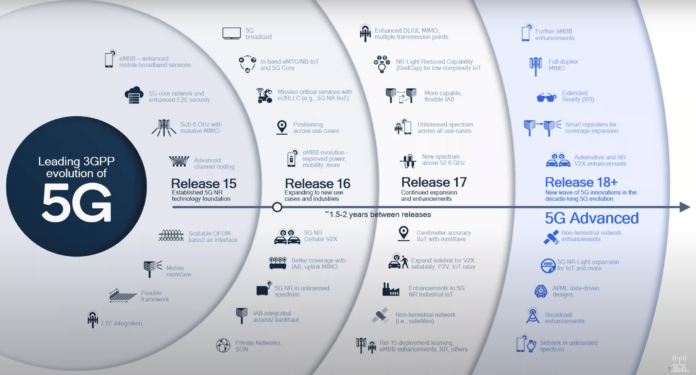5G Advanced covers end-to-end system enhancements and expansion to more device types and use cases
Global 5G deployments are outpacing historical LTE deployment trends, and adoption of compatible smartphones is similarly ahead of expectations. But 5G is still very much a work in progress with standards body 3GPP set to begin nominal work on 5G Advanced Release 18 work and study items in the second quarter of this year.
In a recent webinar hosted by RCR Wireless News, Qualcomm Technologies, Inc. Vice President, Technical Standards, Juan Montojo detailed the end-to-end system enhancements and expansion to new device types and use cases coming with Release 18.
5G Advanced system-level enhancements
Many of the study and work items that fit under the system-level enhancements umbrella are all about helping network operators maximize the efficiency of spectral and radio resources while enhancing quality of experience for an increasingly diverse mix of connected devices. Montojo called out downlink and uplink enhancements for MIMO radio arrays; making Integrated Access/Backhaul (IAB) nodes mobile; situationally aware smart repeaters; AI/ML-driven network design; enhanced mobility; getting closer to full-duplex transmissions; and optimizing power consumption at both the UE and baseband.
A key area that hits on both network efficiency and QoE is around 5G device mobility management so there’s not an interruption when moving between sites. The focus at 3GPP, Montojo said, is developing a conditional handover mechanism that would allow the UE to transition from one cell to another if certain parameters are met. “The network already would be prepared and the UE would know the network is prepared.”
Drilling down further into mobility management for millimeter wave spectrum, Montojo discussed how beam management is currently handled on a cell-by-cell basis. But, “Can I extend my beam management to inter-cell? Can I start acting as if I were in a supercell where beams on neighboring cells could be chosen more dynamically?”
Another area of 5G Advanced that’s tied to created more network dynamism is for Dual Connectivity. While early considerations where around moving from just a primary and secondary link to potentially adding a third or fourth simultaneous connection. Instead of that route, Montojo said a better solution could by dynamic selection of a secondary link chosen from a subset of pre-configured link options. “It would enable you to swap secondary cell groups from a set of actually underlying prepared ones…It’s an augmented Dual Connectivity.”
New device type and use case support coming with 5G Advanced
As 5G networks proliferate, there are two vectors of new devices being added. In addition to smartphones, consumers and enterprises are adopting cellular-connected watches, tablets, PCs and, at an increasing rate, Extended Reality (XR) devices. The other big driver is IoT-type devices, which cover a huge range of form factor and data consumption/creation profiles; HD cameras streaming video into AI-based decision-making engines require a different resource load than connected water meters that may send only small pieces of information at fixed time intervals.
Montojo described the goal with the evolution to 5G Advanced as developing a scalable, unified air interface that allows for coexistence between devices. He grouped the type and needs of devices into three buckets: High performance gear like XR headsets that require high capacity and low latency; less complex and demanding devices like health monitors and logistic trackers; and various NB-IoT- and eMTC-type sensors.
The big picture here, Montojo said, is pushing toward the full realization of the 5G vision for a connected, intelligent world. After that, in the Release 20 or Release 21 timeframe, study of 6G will formally begin.
He called it the “merging of worlds. We have the compute, we have perception, we have the radio component, and we have this moving more and more things to the edge both from the network side as well as from the terminal side. This is going to create effectively the ability for new human interfaces…As you can imagine, things do not get done overnight. We’re going to see all these releases of NR…will actually make it possible for 6G to adopt them and basically get them introduced from the beginning.”
Click here to access the full webinar, “Setting off the 5G Advanced evolution with 3GPP Release 18.”

